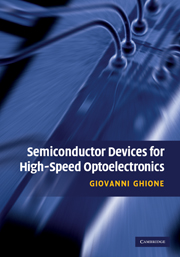3 - High-speed semiconductor devices and circuits
Published online by Cambridge University Press: 03 February 2010
Summary
Electronic circuits in optical communication systems
As well as optoelectronic devices such as optical sources, modulators (electrooptic or electroabsorption), optical amplifiers and detectors, high-speed optical communication systems also include dedicated electronic circuits and subsystems. Although most of these are in the low-speed digital sections of the system, and can therefore be implemented with conventional Si-based technologies, some strategic components and subsystems operate at the maximum system speed, e.g., at 10 Gbps or 40 Gbps, often with rather demanding requirements in terms of noise or output voltage (current driving) capabilities. Since high-speed digital data streams are ultimately transmitted and received in baseband, high-speed (high-frequency) subsystems must also possess ultrawide bandwidth. Relevant examples are the driver amplifiers of lasers or modulators (in direct or indirect modulation systems, respectively), and the detector front-end amplifiers.
The enabling technologies in high-speed circuits for optoelectronic systems are the same as found in RF, microwave and millimeter-wave analog integrated circuits. In these domains, silicon-based (CMOS or bipolar) electronics with conventional integrated circuit (IC) approaches are replaced, at increasing frequency, by ICs based on SiGe or III-V compound semiconductors (GaAs or InP). Such circuits exploit, as active devices, advanced bipolar transistors (heterojunction bipolar transistors, HBTs) or heterostructure-based field-effect transistors (such as the high electron mobility transistors, HEMTs).
Besides active devices, high-speed circuits also include passive (distributed or concentrated) elements. Examples of distributed components amenable to monolithic integration are planar transmission lines such as the microstrip and the coplanar lines on semiconductor substrates. The transmission line theory also enables one to readily introduce, as a typical high-frequency modeling and characterization tool for linear multiports, the scattering parameters.
- Type
- Chapter
- Information
- Semiconductor Devices for High-Speed Optoelectronics , pp. 104 - 157Publisher: Cambridge University PressPrint publication year: 2009



